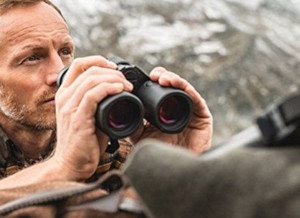7 Best Rangefinder Binoculars of 2025 – Reviews & Buying Guide
Last Updated on

Getting the right rangefinder binoculars can sometimes seem like an impossible task. Sometimes you see them go for hundreds or thousands of dollars and think that there aren’t any more affordable options. Or you’ve seen some that carry high price tags but don’t live up to expectations.
The good news is that it doesn’t have to be that way. Our reviews of the best rangefinder binoculars show you what you should be paying attention to when shopping. We cover the best and worst qualities of several, so you can find one that meets your needs, within your budget.
Our buyer’s guide is designed to help you get the information to make a good selection, even if you’ve never owned one of these great devices before. That way, you can get a great deal on a set you’ll love.

A Quick Look at Our Favorite Choices in 2025:
| Image | Product | Details | ||
|---|---|---|---|---|
| Best Overall |
 |
Leica Geovid HD-B 3000 |
|
CHECK PRICE |
| Best Value |
 |
Nikon LASERFORCE |
|
CHECK PRICE |
 |
Vortex Optics Fury HD |
|
CHECK PRICE | |
 |
Bushnell Fusion 1-Mile ARC |
|
CHECK PRICE | |
 |
ZEISS Victory RF |
|
CHECK PRICE |
The 7 Best Rangefinder Binoculars:
1. Leica 10×42 Rangefinder Binocular – Best Overall

If you’re looking for the best rangefinder binoculars for hunting or target practice, you’ll love the Leica 10×42 Geovid HD-B 3000 Rangefinding Binocular. This model comes with excellent 10x magnification, which gives you a decent field of view at long range but also provides the magnification you need to spot deer and even smaller animals. It also works up to 3000 yards away, which means this set has a fantastic range. It has a lightweight magnesium-alloy chassis, which is roughly as strong as steel, at a fraction of the weight.
What really sets this model apart, however, is its ABC Ballistic Compensation System. Tell the binoculars what kind of bullets you’re using, and it will calculate the angles required to hit the target, making shooting that much easier. The one thing we think could be better is the weight. Even with the lightweight magnesium-alloy shell, this monster weighs 4.4 pounds. It’s hard to imagine what it would weigh with a heavier shell. However, if you’re looking for a pair of rangefinding binoculars that will make the hunt easier and don’t mind a little extra weight, these will serve you well.
- Good magnification
- Incredible range
- Magnesium chassis
- ABC Ballistic Compensation System
- Heavy
2. Nikon LaserForce Rangefinder Binoculars – Best Value

The Nikon LASERFORCE RANGEFINDER Binocular is another great pair of rangefinder binoculars from a great company. Nikon has long been known for its optics, but this set shows that its laser technology is up to par as well. This model can range deer out to 1200 yards and can detect trees 200 yards beyond that. It also gives you readings in .1-yard increments up to 100 yards away. After that, it gives readings in 1-yard increments. This pair of rangefinding binoculars are also both waterproof and fog proof.
However, the best thing is its low price. It’s roughly as good as the top choice on our list, but you can get it for about one-third of the price. That makes this pair the best rangefinder binocular overall value for the money here, so if you’re looking for a great product at a great price, this is the one you want. The only issue is the rubberized outer coating, which is prone to attracting dirt and grime. Still, if you’re looking for great binoculars that give you a ton of value for the price, these qualify.
- Good range
- Excellent close accuracy
- Waterproof/fog-proof
- Great price
- Rubberized coating attracts dirt
3. Vortex Fury 10×42 Binoculars

The Vortex Optics Fury HD 10×42 Laser Rangefinding Binocular does some things well that other rangefinding binoculars don’t. For instance, it has brightness settings, so you can use it comfortably during the day and at dawn and dusk while lowering your power consumption. It’s waterproof and fog proof, so it’s safe to use in wet conditions. You can focus both eyepieces and the reticle independently, so you get images and overlays that are as clear as possible, no matter what your vision is like. There aren’t many binoculars, especially at this price point, with that feature.
These rangefinding binoculars also have angle-compensation technology, which is especially useful for bowhunters, but pays dividends for all kinds of hunters. However, this model can’t crack the top two due to underwhelming clarity. Both the image and the reticle aren’t as clear as our top picks. The poor image quality makes it hard to find your targets and range them successfully, which is a pretty big problem for a rangefinder. For most people, it’ll make sense to get one of the other binoculars available at a similar price point.
- Waterproof/fog proof
- Brightness settings
- Angle-compensation mode
- Independent focusing
- Underwhelming clarity
4. Bushnell Fusion Rangefinder-Binoculars

The Bushnell Fusion 1-Mile ARC Binocular Laser Rangefinder is from a storied brand and lives up to that name in a few ways. It has an extremely long-range for a rangefinding binocular at its price point. Since it can detect objects up to 1760 yards away, you’ll be able to spot objects very far off. It’s also waterproof and fogproof, so inclement weather won’t force you to leave this great tool at home. Despite its long range, it offers accuracy to within one yard at all distances.
Unfortunately, it can be hard to get this set to lock onto a target if it isn’t well-lit. If you’re hunting or target shooting in the woods, it can be hard to get the rangefinder to give an accurate result. It also has a poor-quality rubber cover that sometimes falls off the binoculars. That’s a pain to deal with, and you’d hate to lose it while you were out in the woods. This is a decent rangefinder, but if you want one that performs in all conditions, you won’t be happy with this one.
- Long-range
- Waterproof/fogproof
- Good accuracy
- Target must be well-lit
- Poor-quality rubber cover
5. ZEISS Victory 10×42 Binoculars

The ZEISS Victory RF 10×42 comes at a premium price. The good news is that it has the features to live up to those expectations. It has automatic brightness adjustment, which can save you a lot of time in the field. It’s also Bluetooth-enabled, so you can connect it to ZEISS’ smartphone app, where you can save information about the firearms and ammunition you use. That allows the rangefinder’s Ballistic Information System to help guide your shot and give you the information you need to make accurate long-range shots.
While this is a good pair of rangefinding binoculars, we can’t rank it higher than fifth on our list. For one, they cost more than our top choice, even though you can get most of the features that come with this model on more affordable rangefinders. It’s also heavy. At more than two pounds, you’ll notice the weight while you carry it around, and it can wear on your neck. Overall, this is a good pair of binoculars, but the very high price means it’s not going to be good value for most people.
- Automatic brightness adjustment
- Bluetooth-enabled
- Ballistic information system
- Price
- Weight
6. Steiner Laser Rangefinder Binoculars

The Steiner Laser Rangefinding Binoculars LRF 1700 is another high-priced rangefinder that falls short of its lofty price. It’s waterproof and fogproof, so it’s always safe to use outdoors, and it can survive submersion in water for short periods. It also has a long range. Since it can measure out to 1859 yards, few targets will be able to elude this device. It focuses automatically, so you won’t have to worry about making adjustments.
These rangefinding binoculars weigh three pounds. You have lighter options, and most people will be better off with one of those. This one also has poor lens covers. They sometimes pop off, and they don’t always get a good seal, so moisture sometimes gets inside and collects in front of the lenses. That’s a tricky problem to solve and can lead to your lenses getting smudged, lowering your clarity. You don’t have a lot of ways of fixing the problem in the field. This isn’t a tool that many people will like in the long run, which makes it a poor choice given the price.
- Waterproof/fogproof
- Long-range
- Auto-focusing
- Weight
- Poor lens covers
7. Swarovski 10×42 Laser Rangefinder Binocs

The Swarovski 10×42 EL Range Binocular / Laser Rangefinder is a high-priced set that doesn’t live up to its price in many areas. On the plus side, it does have a high-quality magnesium-alloy chassis, which is both lightweight and durable. These binoculars are nitrogen-filled, so they won’t fog up if water ever gets inside. However, this rangefinder has an underwhelming range. It’s only capable of detecting reflective objects at 1500 yards and has an effective range far shorter than that. Given that it’s not as good as the competition in this area, it’s not great value for the money.
It’s also hard to get good customer service if anything goes wrong. The company is generally hard to reach, and frequently non-responsive, which makes it very hard to resolve any problems you have under warranty. Given these serious problems, it’s hard to make the case that this model is worth the price. This is a tool that will leave most people feeling like they got ripped off. The good news is that you can get better rangefinding binoculars for less money.
- Magnesium-alloy chassis
- Nitrogen-filled
- High price
- Underwhelming range
- Poor customer service

Buyer’s Guide: How to Choose the Best Rangefinder Binoculars
Optics
While many users focus on the rangefinder half of rangefinder binoculars, it’s important to make sure you’re getting a good pair of binoculars at the same time. If you can’t scan the distance effectively, you’ll need to carry a second pair of binoculars.
We recommend that you get a binocular with between 8x and 10x magnification. Any more, and it’ll be hard to hold them still enough for the rangefinder to work. Any less, and you won’t get enough magnification to spot animals at long range.
You’ll typically want larger lenses. The bigger the lens is, the more light it lets in, and that leads to sharper detail and makes it easier to spot animals. Wider lenses also lead to a wider field of view, which is useful at long ranges.
Rangefinder
While the optics are important, it’s still a good thing to get a good rangefinder. However, something every rangefinder user needs to consider is how often they’ll need distances over 1000 yards. Most people need far less than that, especially when they’re shooting. It can also be very difficult to keep your hands steady enough to mark targets long enough to measure the distance when they’re further away than 1000 yards.
While many people are interested in models that use information about your setup to help calculate bullet or arrow trajectories, these systems are largely found in high-end rangefinders, so it’s a good feature to drop from your list if you’re looking for something lower-priced.
See also: Is it worth it to buy a laser rangefinder for under $200 – Or should you pay more?
Durability
Durability is important in every product, but it plays a special role with devices that will be used outside and possibly in wet weather. The best rangefinder binoculars on the market are waterproof and fog proof. Otherwise, they’ll fog up in humid weather.
They also need a durable outer shell. Aluminum, steel, and magnesium shells all work well, providing different mixes of weight and strength. Never get binoculars that come with a plastic case. Drop that too many times, and it cracks, or it bends just enough to let water in, ruining the binoculars.
You’ll also want a set with durable accessories, like a neck strap and case. While these are sometimes replaceable, for the price you have to pay for rangefinding binoculars, you’ll want accessories that last.

Conclusion
The Leica 10×42 Geovid HD-B 3000 Rangefinding Binocular is our favorite due to its good magnification, incredible range, and magnesium-alloy chassis. The second-place Nikon LASERFORCE RANGEFINDER Binocular is excellent at close range, has a good overall range, and is waterproof and fog proof. The low price makes it the best value for the money on our list. Third place belongs to the Vortex Optics Fury HD 10×42 Laser Rangefinding Binocular, which has brightness settings, an angle-compensation mode, and independent focusing. Its underwhelming clarity keeps it out of the top spots.
The Bushnell Fusion 1-Mile ARC Binocular Laser Rangefinder takes fourth place with its long-range and good accuracy, but its struggles in dim light and poor-quality rubber coating hurt its value. The fifth-place ZEISS Victory RF 10×42 has automatic brightness adjustment, is Bluetooth-enabled, and has a ballistic information system, but its high price and weight make it poor overall value. The Steiner Laser Rangefinding Binoculars LRF 1700 are waterproof and fog proof and have a long-range, but the high weight and poor lens covers put them in sixth. The nitrogen-filled Swarovski 10×42 EL Range Binocular / Laser Rangefinder has a magnesium-alloy chassis, but its underwhelming range, high price, and poor customer service combine to drop it to the last place.
We hope these reviews and buyer’s guide have helped you learn about rangefinder binoculars, and have helped you find some that are right for your next hunting expedition.
Other types of binoculars we’ve reviewed:
About the Author Robert Sparks
Robert’s obsession with all things optical started early in life, when his optician father would bring home prototypes for Robert to play with. Nowadays, Robert is dedicated to helping others find the right optics for their needs. His hobbies include astronomy, astrophysics, and model building. Originally from Newark, NJ, he resides in Santa Fe, New Mexico, where the nighttime skies are filled with glittering stars.
Related Articles:
When Were Binoculars Invented? History, Today & Future
How to Clean a Refractor Telescope: Step-by-Step Guide
How to Clean a Telescope Eyepiece: Step-by-Step Guide
How to Clean a Rifle Scope: 8 Expert Tips
Monocular vs Telescope: Differences Explained (With Pictures)
What Is a Monocular Used For? 8 Common Functions
How to Clean a Telescope Mirror: 8 Expert Tips
Brightfield vs Phase Contrast Microscopy: The Differences Explained



